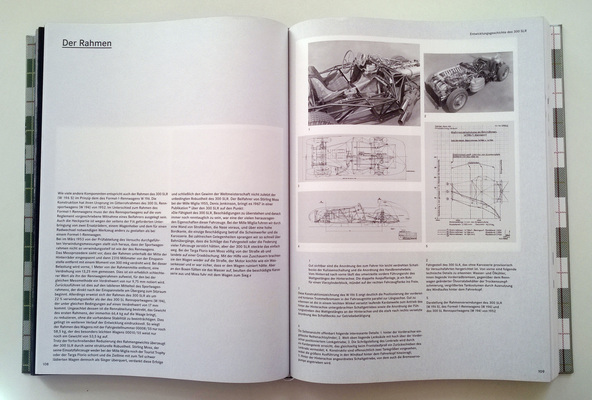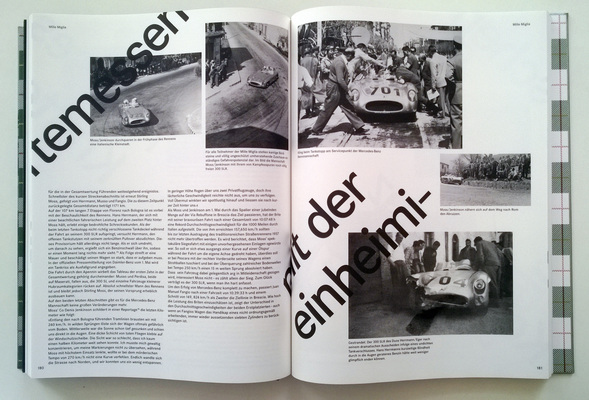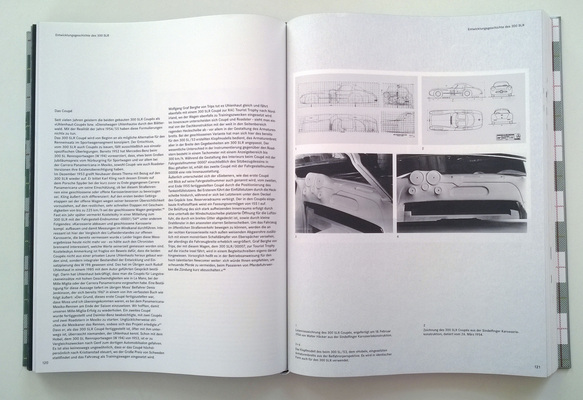The Hatje Cantz publishing house's announcement states: "Based on extensive research in the Mercedes-Benz Classic archives, this book documents the technical development of the W 196 S, all racing events and the biography of every single vehicle built in a comprehensive and authentic manner.
The book is a "bibliophile collector's item" thanks to its partly unpublished images and illustrations, high-quality graphic design and exquisite layout. This entitles it (naturally) to be published by an art publisher under the heading of cultural history!

Aiming for the Road World Championship
The Mercedes-Benz 300 SLR was built in 1955 as a pure racing sports car with the aim of winning the World Sports Car Championship. Although the type designation suggests it, it was not directly related to the 300 SL racing car (W 194) or the 300 SL road sports car with gullwing doors (W 198).
Instead, the W 196 S was derived directly from the Formula 1 racing car used at the time, the W 196 R. The W 196 S adopted the technical concept from the monoposto. However, modifications were necessary for use in sports car racing. These included, in particular, the design as a two-seater vehicle and the increase in engine capacity from 2.5 to 3 liters.
Complex engine design
The M 196 engine, and thus also the M 196.I used in the racing sports car, consisted of two four-cylinder engines, with the power being taken from between the two blocks. It therefore had two crankshafts and four overhead camshafts. Particularly noteworthy is the use of positive valve timing, which was expected to increase the engine speed to over 10,000 revolutions per minute. It was also the first racing engine ever to feature fuel injection.

The tubular frame was basically taken over from the W 196 R, but had to provide additional space for a passenger, two spare wheels, a jack and the tools for a wheel change.
Small series
A total of nine W 196 S vehicles were built. Two of these were coupés, the so-called Uhlenhaut coupés, which were never used in races.
Six races were contested with this car, of which Mercedes won five: the Mille Miglia, the Eifelrennen, the Swedish Grand Prix, the Tourist Trophy and the Targa Florio. The sixth was the 24 Hours of Le Mans, in which Pierre Levegh's W 196 S was involved in a collision through no fault of its own and was thrown into the spectators. It was one of the biggest disasters in the history of motor racing. Mercedes withdrew the remaining cars during the race.
The drivers
The drivers were Juan Manuel Fangio (6 appearances), Stirling Moss (6), Karl Kling (5), John Fitch (3), André Simon (2), Peter Collins (1), Hans Hermann (1), Pierre Levegh (1), Desmond Titterington (1) and Wolfgang Graf Berghe von Trips (1), by far the most international squad in the World Sportscar Championship at the time. Remarkably, the young Moss was involved in all the victories in the world championship races (Mille Miglia, Targa Florio and Tourist Trophy). His victory in the Mille Miglia together with the journalist Denis Jenkinson as navigator is legendary. Fangio won the two "short" races at the Nürburgring and in Sweden. With a total of three victories, Mercedes-Benz won the 1955 World Sports Car Championship against Jaguar with two and Ferrari with one.
The book contains a first part with pictures, which are printed on both sides and organized according to the individual races. It is supplemented by a few pages with press clips and the schedule of the individual vehicles.
This is followed by the main section with a foreword, an overview of "The people behind the 300 SLR (The makers)" the development history, the racing events and future developments. Finally, there is a detailed list of footnotes and an appendix with an index.

The people behind the car
Wilhelm Haspelt, Fritz Nallinger, Rudolf Uhlenhaut, Ludwig Kraus, Karl-Heinz Göschel and Alfred Neubauer are presented as the movers and shakers. They are counted among the small circle of personalities who were each responsible for the success of the 300 SLR in different positions. Not mentioned are Hans Scherenberg, who at the time was head of passenger car design at Daimler-Benz AG, and Walter Kostelezky, head of the racing workshop. This narrow interpretation of the circle of those responsible for the success also conceals the fact that the success of the Daimler-Benz racing team in 1954-55 was also due to the excellent and potent organization. This shines through again and again in the book, and this statement in no way diminishes the achievements of the team's creators. A list of all the employees in the departments involved, including all the mechanics, can be found in Michael Riedner, Mercedes-Benz W196: Der letzte Silberpfeil, 1986 on page 303.
The development history is divided into the following sections:
- The M 196.I engine series
- The gearbox
- The frame
- The chassis
- The body (divided into roadster and coupé)
- The vehicle biographies (with all data for all nine vehicles including a commentary on the unrealized 196.110-00009/55)
Factual, sober, remarkable
The foreword announces the following qualities: sober facts, emotional photos, meticulously researched. All of this can be fully confirmed. A complete description is provided for each individual vehicle (each individual chassis number) with all the modifications that were carried out (e.g. the installation of the air brake for the race at Le Mans) or had to be carried out when the cars returned from the races damaged. The coverage of the accident at Le Mans is remarkably factual and avoids any polemics.
The technical documentation is excellent with many drawings, detailed pictures and measurement results. Sometimes one wishes that the prints were a little larger so that all the lettering was legible.
The description of the individual vehicles is also exceptionally detailed. The engine outputs of the individual engines used in the respective vehicles are documented. Across all twelve documented engines, the power output fluctuated between 288 and 302.5 hp at around 7,450 rpm, which documents a very high level of consistency and repeatability for racing cars. The stability measured as maximum speed for x seconds is also specified. For each car, there is a CV with the date of test runs, test drives, training sessions and races as well as the respective mileage after returning to the factory. There is also information on the current whereabouts. The gearbox and final drive ratios are specified for each race.

All of this was only possible because those responsible at the time attached great importance to detailed documentation and applied the same high standards in the development of the racing cars as in series development.
A highlight is of course the description of the Uhlenhaut coupés, which have their own section in the chapter on the bodywork. [A minor note: on page 153, the road registration number of the first coupé (196.110-00007/55) is given as W 21-6962 instead of W 22-6952]. An important note is that these coupés were not the whim of a duly authorized employee of Daimler-Benz AG, but were an integral part of the development program.
Looking to the future
The most exciting part, in my view, can be found under "Future development". The original plan was to withdraw from Formula 1 at the end of 1955, but to contest the sports car world championship again in 1956. The experience gained in racing in 1955 was therefore used to analyze the identified weaknesses and develop new concepts in the same year. The in-line eight-cylinder engine proved to be very sensitive to vibrations and it was therefore not possible to exploit the potential of desmodromic valve control.
At first glance, the design of the book appears very sober. Although strictly in the colors white, black and various shades of grey (including silver), it is actually opulent: packed in two slipcases, printed in the so-called Japanese style, in which the sheets are printed on one side only and then folded. It also includes a facsimile of Denis Jenkinson's report from Motor Sport (June, 1955): "With Moss at the Mille Miglia".
In two languages
There is a version in German and one in English. Both are limited to 1,000 numbered copies.
With a price of 199 euros and an elaborate design, the book is intended for collectors who want to document their possessions in their living room. The presentation with two slipcases limits its use as a reference work anyway. There is also a latent risk of addiction associated with the book, as it is volume 1 of the Milestones of Motorsport series. Volume 2, which is also scheduled for 2015, is dedicated to the Mercedes-Benz 300 SL racing sports car (W 194).
This means that the circle of potential buyers is probably quite limited. It is primarily aimed at people with a strong emotional connection to Mercedes-Benz. However, those interested in the development of racing car technology will also find valuable information in this book.
The layout and price certainly meet the requirements of Mercedes-Benz or, in this case, Mercedes-Benz Classic. However, the question arises as to whether a B version, i.e. an additional, cheaper edition, would not be a favor to the freaks and fans who are primarily interested in the content rather than the presentation. As a partial replacement, however, we can still recommend the above-mentioned book by Michael Riedner. It also contains a chapter on the W 196 S.
Bibliographical details
- Title: Mercedes-Benz 300 SLR: Milestones of Motorsport Volume 1
- Authors: Daimler AG, Mercedes-Benz Classic with text by Günter Engelen
- Publisher: Hatje Cantz
- Edition: 1st edition 2015 (numbered and limited to 1,000 copies)
- Size/format: 278 x 365 mm, 254 pages, 316 illustrations, cloth cover, in two slipcases, with color cut; with a facsimile by Denis Jenkinson: "With Moss at the Mille Miglia", from Motor Sport June 1955
- Language: German or English
- ISBN-13: 978-3-7757-4000-5 (German edition)
- ISBN-13: 978-3-7757-4001-2 (English edition)
- Price: 199.00 Euro
- Order/buy: Online at amazon.de
or in well-assorted bookstores
























